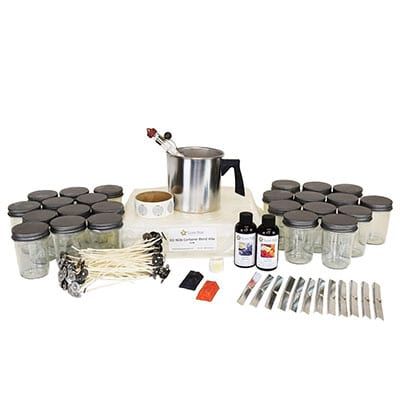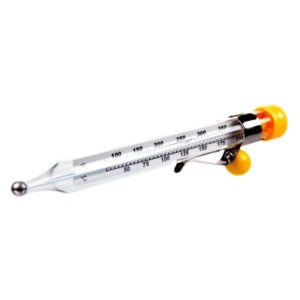What You Should Know Before You Make Your First Candle

It seems that everywhere you look these days people are attempting more and more DIY projects. Whether it’s building furniture, baking cupcakes, painting your house, paving your driveway or erecting a building…there are TONS of DIY tutorials out there. Many people look at projects such as making candles and think “hey…I could do that. How hard could it be?” Truthfully, making candles is not too difficult but there are a few things you need to know before you get started.

Purchase the Right Materials
Like many DIY projects, candle making can’t really be done with things that you may have lying around your house. You will need to buy the proper supplies and equipment to be sure that you are safe and making quality candles. You wouldn’t want to spend all that time and have a candle that won’t burn!
These supplies include:
Wax that is designed specifically for candle making - Make sure you choose a wax (soy, paraffin, palm, etc) hat is right for the candle you want to make. Many waxes are designed for specific purposes so make sure you select a container wax for container candles and a different wax for your tarts, pillars, etc. Click here to browse our selection of waxes.
Candle dye - Crayons are NOT recommended to use as candle dyes because they are not made of wax that is meant to burn like candle wax. More often than not, crayons end up clogging your wick which results in a candle that does not burn properly.
Fragrance oils or essential oils - Adding perfumes to your candles can be hazardous. Make sure you use fragrance oils or essential oils in your candles, just make sure the essential oils you choose are safe for candle-making. We have 300 different fragrance oils to choose from!
Wicks - Not all wicks are created equal. Make sure you purchase a wick that will work with the wax you are using and will ensure a proper melt pool for your candle. You can read more about the wicks we sell and choose the proper size wick for your candle in the Guide to Wicking found in our Candle Making University.
Containers and molds - Make sure your glass, metal, or ceramic containers will be able to take the heat from your candle. We have a great selection of glass jars and lids to choose from that have all been approved for candle making. You’ll also want to make sure your mold can take the heat from the hot wax you are pouring into it. Metal or silicone molds are recommended.
Equipment - Making candles can be dangerous; you are working with heat and chemicals if you use synthetic fragrance oils. You will want to make sure that you have a thermometer to keep an eye on temperatures, a pouring pot that can withstand the heat from your wax and your heat source, a digital scale to measure your wax and fragrance, and possibly gloves to protect your skin from fragrance oils and dyes.
We offer a few different starter kits that have EVERYTHING you need to get started making your first candle. Check them out!

Pay Attention to Measurements & Temperatures
Measure your fragrance oil - How much fragrance oil is too much? The amount of fragrance oil you can add to your wax depends on the wax itself. Usually, a good rule of thumb is to add 1 oz of fragrance oil to 1 lb of wax but some waxes can't hold that much while others may hold twice that much! Adding more fragrance oil to your wax (especially if it is over the wax's retention limit) does not always guarantee a stronger scent throw. Sometimes, adding too much fragrance oil can clog your wick which can cause it to smoke and soot and weaken your scent throw. You may also see the fragrance separate from the wax over time if you add too much, which can be unappealing and pose a possible fire hazard. On the other end, you might not be adding enough fragrance oil to your wax which can result in a very weak scent throw. Always check the recommended amount for your wax before making your candles to ensure that you are adding the correct amount of fragrance oil. You can find this information in the Candle Making University under Choosing a Soy Wax and Paraffin Wax Guidelines. We recommend measuring both your wax and fragrance by weight to avoid having to do any math involved in converting fluid ounces to ounces by weight.
The temperature at which you add your fragrance oil - For soy and paraffin waxes, you’ll want to add your fragrance oil at around 180-185 degrees but other waxes can be higher, like palm wax. For this wax you will add your fragrance oil at around 200-205ºF. Adding your fragrances at these temperatures helps it bind to the wax which will help your candle have a stronger scent throw. Adding your fragrance at a temperature that is too low can result in a weak scent throw, and nobody wants that!
Pouring temperature - Each wax will have a slightly different temperature at which you will pour it into your container or mold. These temperatures are recommended to help your candle have a nice, smooth finish, adhere to your jars, and avoid doing multiple pours when applicable. Pouring too hot can cause the wax to set up rough, create sinkholes and even damage your container. Pouring too cold can cause jump lines and allow poor adherence to jars. You can find the recommended pouring temperatures for the waxes we carry in our Candle Making University under Heating & Pouring Waxes.

TEST, TEST, TEST...And Test Some More!
A common mistake that many beginners make is mass producing their candles BEFORE they do a test burn. Sometimes, you can follow all the steps, measure everything perfectly, and your candle looks great, but then find out your candles don’t burn properly. Sometimes, you can have an awesome cold throw but no hot throw. Maybe your wicks don’t burn hot enough for your candle, or maybe even too hot. Really, the list of things that can happen goes on and on. The best practice is to test burn each type of candle you make. Adding a new fragrance, a new wick, trying a new jar, a new dye, etc. each component can affect how your candle burns.
A good rule of thumb is to burn your candle for one hour for every inch it is wide. So, if you have a candle that is 3 inches in diameter, you should burn your candle for at least 3 hours to make sure it gives you a good scent throw, a proper melt pool, and doesn’t cause your wick to smoke.
Don't be Scared. Have Fun With it!
A lot of this may sound overwhelming, and we promise we aren't trying to scare anyone off. Making candles can be really fun! Many people even find making candles therapeutic. It’s so satisfying when you are burning a candle, and someone compliments how pretty it is or how great it smells. As long as you are well informed, prepared, and take your time, you can make great candles!